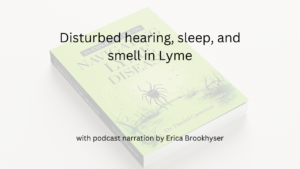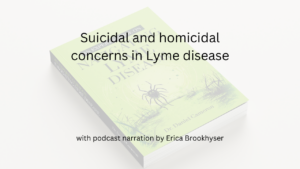Call for your appointment today 914-666-4665 | Mt. Kisco, New York

Welcome to an Inside Lyme case study. I find that the best way to get to know Lyme disease is through reviewing actual cases. In this case study, I will be discussing a 5-week old baby girl with Lyme disease. This case series will be discussed on my Facebook and made available on podcast and YouTube.
In this episode, I will be discussing a 5-week old baby girl with Lyme disease.
This case was described in the journal Pediatrics, written by Handel and colleagues in 2019.
This paper reminds parents of the need to look for a tick bite and Lyme disease even in babies. The authors described a healthy 5-week-old girl who was diagnosed with Lyme disease. The baby girl lived in Long Island, New York, an area endemic for Lyme disease. The baby was rarely outdoors, but the family dog was allowed outdoors. The dog could have brought the baby in contact with the tick. Other researchers have reported a higher risk of Lyme disease in pet owners.
The parents did not report seeing a tick. Instead, the parents removed “an engorged, black “bug” from behind her left ear six days before symptoms started.” writes Handel. This highlights the difficulties parents can face in recognizing a tick.
[bctt tweet=”This paper reminds parents of the need to look for a tick bite and Lyme disease even in babies.” username=”DrDanielCameron”]
The fact that the presumed tick was engorged was also important. The risk of Lyme disease from an engorged tick is much higher. The number of spirochetes rises as the tick takes a blood meal. The spirochetes in a tick have more time to multiply and migrate from the midgut of the tick to the salivary glands. The higher numbers of spirochetes in the salivary gland, the more likely the bite will lead to a tick-borne disease.
The baby girl was diagnosed with early disseminated Lyme disease. The rashes were typical with “multiple flat rings with peripheral blanching erythema, a central clearing, and outward expansion without tenderness or peripheral scaling” writes Handel. He added, there was also a rash near the bite. Early disseminated Lyme disease often occurs without the initial erythema migrans rash when the bacteria have already spread throughout the body.
The doctors hospitalized the baby. The baby had a fever 101.1 and was irritable. The tick-borne tests were negative, which is common in early Lyme disease. The western blot Lyme disease test was not performed, as the ELISA screen was negative.
The doctors were concerned that the baby might suffer from Lyme meningitis. This is an uncommon but important concern for the doctor treating Lyme disease. The spinal tap was not successful. The doctors treat for Lyme meningitis with intravenous antibiotics since they were still concerned the baby might have Lyme meningitis. The baby girl was discharged from the hospital after two weeks of intravenous ceftriaxone.
There were no complications on follow-up, according to the doctor.
The authors noted that there are few cases of babies being treated for tick-borne illnesses in the published literature. That does not mean that young children aren’t contracting tick-borne diseases in practice. Children under the age of 5 years-of-age are the most likely to be infected with Lyme disease according to the CDC.
What can we learn from this case?
- Babies can be infected with a tick-borne infection even with little outdoor exposure.
- The family pet can bring a baby into contact with ticks.
- It can be difficult to determine if a baby has Lyme meningitis. The spinal tap in this 5-week-old baby girl was unsuccessful. Even if the spinal tap had been successful, the spinal tap may be negative in neurologic Lyme disease.
What questions does this case raise?
- Would it have been helpful if the parents had recognized the “bug” as a tick?
- Would the parents or the doctor have recognized Lyme disease if the rash were single or atypicial? The most common rash is a flat red rash in one study.
- Would the baby have been successfully treated with oral antibiotics rather than intravenous antibiotics?
- What if the baby did not have a rash? Would the doctor have been willing to use clinical judgment to diagnose Lyme disease in a baby?
- Would the IgM western blot test for Lyme disease have been positive if the doctor had ordered a western blot test? The IgM western blot test is often positive in early Lyme disease.
- Would antibiotic treatment at the time of the engorged tick bite have prevented the need for a 24 days hospitalization, a spinal tap, and intravenous antibiotics in the baby girl?
- When is it important to perform a spinal tap?
- Will the baby girl develop a co-infection like Ehrlichia, Anaplasmosis, and Babesia? This is particularly important as the intravenous ceftriaxone prescribed for the baby would not be effective for these tick-borne infections.
- Will two weeks of intravenous antibiotics prevent chronic manifestations of Lyme disease?
Treating Tick-Borne Disease In My Practice
In my practice, each individual requires a careful assessment. That is why I order tests a broad range of tests, including blood counts, liver and kidney function, thyroid disease, lupus, and rheumatoid arthritis in addition to tests for tick-borne infections. I also arrange consultations such as neurologists, rheumatologists, and ophthalmologists.
Many patients are complex, as highlighted in this Inside Lyme Podcast series.
We need more doctors with skills diagnosing and treating Lyme disease in children. We could use a reliable test to determine who has Lyme disease and a test to be sure Lyme disease has resolved. We need to determine the best course of treatment for babies. In this case, were there oral antibiotics that would have been effective? We hope that if a professional sees a baby that they can use this case to remind them to look for Lyme disease and treat accordingly.
We also need to give doctors the freedom to treat these difficult cases without undue interference by colleagues, insurance companies, medical societies, and medical boards.
Inside Lyme Podcast Series
This Inside Lyme case series will be discussed on my Facebook and made available on podcast and YouTube. As always, it is your likes, comments, and shares that help spread the word about this series and our work. If you can, please leave a review on iTunes or wherever else you get your podcasts.
Sign up for our newsletter to keep up with our cases.
References:
- Two Neonates With Postnatally Acquired Tickborne Infections Andrew S. Handel, Harriet Hellman and Saul R. Hymes Pediatrics 2019;144;



